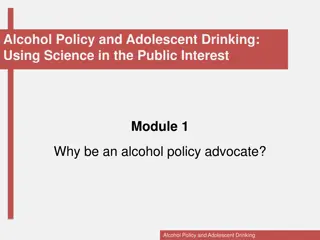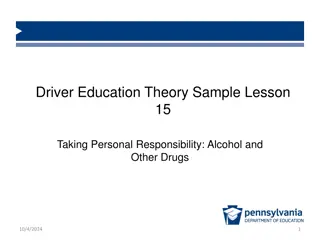Integrating Human Rights into Drug and Alcohol Policy Development for Better Outcomes
The National Collaborative Vision aims to integrate human rights into drug and alcohol policy development to improve outcomes for individuals affected by problem substance use. The purpose is to empower these individuals and ensure their voices are heard in policy decisions. The Roadmap Charter of Rights, using the FAIR model, guides this initiative. Evidence gathering explores barriers to realizing rights, such as the right to health and participation. The right to health must ensure availability, accessibility, acceptability, and quality. A family perspective questions fulfillment of this right in Scotland and calls for necessary changes in law, policy, or practice.
Download Presentation

Please find below an Image/Link to download the presentation.
The content on the website is provided AS IS for your information and personal use only. It may not be sold, licensed, or shared on other websites without obtaining consent from the author.If you encounter any issues during the download, it is possible that the publisher has removed the file from their server.
You are allowed to download the files provided on this website for personal or commercial use, subject to the condition that they are used lawfully. All files are the property of their respective owners.
The content on the website is provided AS IS for your information and personal use only. It may not be sold, licensed, or shared on other websites without obtaining consent from the author.
E N D
Presentation Transcript
National Collaborative VISION: to integrate human rights into drug and alcohol policy development, implementation, monitoring, and evaluation leading to better outcomes for people affected by problem substance use. National Care Service Human Rights Bill
Purpose 1. To empower people affected by problem substance use to enable their voices and, critically, their rights - to be acted upon in policy and decision- making concerning the design, delivery and regulation of drug and alcohol services at a national level. 2. To set out how the rights to be included in the forthcoming Human Rights Bill can be effectively implemented to improve the lives of people affected by problem substance use.
The Roadmap Charter of Rights Using FAIR model
Evidence gathering around barriers to realising rights 1. The right to health (specifically healthcare) + right to life, right not to be subject to degrading treatment 2. The right to health (social determinants) + right to adequate standard of living 3. The right to participation 4. The right to private and family life 5. Criminal justice rights + Right to life, right not to be subject to degrading treatment
The right to health The right to the highest attainable standard of physical and mental health means that drugs and alcohol services need to be designed, delivered and regulated to ensure . Availability e.g. choice of service in sufficient quantity and adequately funded Accessibility e.g. services are geographically and financially accessible Acceptability e.g. services are person-centred Quality e.g. services are evidence-based and trauma informed Acceptability Quality Availability Accessibility
From a families perspective, 1. Is the right to health fulfilled for people affected by problem substance use in Scotland? In terms of Availability, Accessibility, Acceptability, and Quality. 2. If not, in what specific ways is this right not fulfilled for people affected by problem substance use in Scotland? 3. What must change (in law, policy or practice) for this right to be fulfilled for people affected by problem substance use in Scotland? Acceptability Quality Availability Accessibility
From a families perspective, 4. Are health goods, services and facilities related to problem substance use delivered in a way that counters stigma and recognises the inherent dignity of every human person? If not, what are the issues, and what needs to change? 5. Are health goods, services and facilities related to problem substance use designed, implemented and assessed in a way that ensures those most affected are able to participate meaningfully (have their views heard and taken into account)? If not, what are the issues, and what needs to change? 6. When the above rights are breached, are people affected by problem substance use able to effectively challenge practices that breach these rights, and secure a remedy? If not, what are the issues, and what needs to change? Acceptability Quality Availability Accessibility























